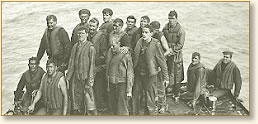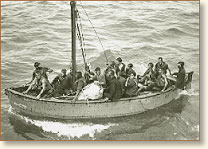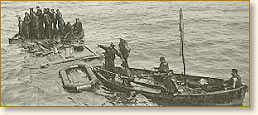|
Sunk By Submarine, 1944
Surrounded by the darkness of a night in mid October 1944, the S.S. John A. Johnson slips under the Golden Gate Bridge on a course from San Francisco to Honolulu. The cargo ship is jammed from bow to stern and from top to bottom with 7,000 tons of military supplies including ammunition and explosives. Even her decks are crowded with trucks bound for the Pacific Theater of war.
The ship carries a crew of 41 Merchant Marine, 28 Navy armed guards and one Army
 |
Part of the crew of the Johnson aboard a raft
as it approaches the rescue ship Argus |
officer in charge of the cargo. She makes her way through the seas alone - no escort, no convoy - and travels at an average speed of 9 knots.
The S.S. John A. Johnson isn't a particularly glamorous ship. She's a
workhorse, one of thousands of such cargo haulers so vital to America's ability
to carry on the War in Europe and the Pacific. At 9:10 P.M. on the night of October
29, she's completed a third of her journey, running in total darkness and under
radio silence when a sailor's worst nightmare becomes reality. Lookouts spot
a telltale wake glistening in the moonlight and headed for the ship. "Torpedo
to starboard!" The cry pierces the darkness and then an explosion as the deadly
missile slams into the ship's hull. The explosion rips the trucks on deck
from their moorings tossing them from side to side like toys. A few seconds and
another explosion in the rear of the ship as a second torpedo deals its deathblow.
"Abandon Ship!" The order rings out as the crew scrambles to their lifeboats or jump over the side to escape the doomed vessel. The water is covered with dark, thick, pungent oil making swimming difficult. But the Nightmare gets worse. The attacker - a Japanese submarine - now surfaces and leisurely makes its way among the lifeboats spraying the crew with machine gun fire. After four hours the attacker decides it has had enough of this game and slips away into the darkness.
In some ways the crew of the S.S. John A. Johnson is lucky. A Pan American Airways passenger plane flying en route over the area, sees the flames of the burning ship and radios San Francisco alerting the Navy of the disaster. A rescue ship, the U.S.S. Argus reaches the crew around noon the next day. Of the seventy on board the Johnson, sixty survive the ordeal.
Harold L. Clark is a typical member of the crew of the S.S. John A. Johnson. He's young (many of the crew were 17 or 18) and mans one of the guns protecting the ship. He is one of the crew interrogated by the Captain of the Argus the day following the sinking.
"I was on watch on the starboard wing of the bridge. At about 9:10 (pm), I spotted wake in the water, about four hundred to four hundred and fifty yards away from the ship. I reported wake to the bridge over phone. Missing man (Cloyd) was on the phone at bridge.
Torpedo hit ship, knocking me some fifteen feet away and water and oil came down all over me. General Quarters was sounded.
 |
| A lifeboat approaches the Argus |
Lieutenant Yates came up and told me to help man the number #6 gun. I proceeded to the number #6 gun, and there sighted explosion just astern of ship. It looked like another torpedo. Ship began to break in two. Abandon ship signal sounded on the whistle. I proceeded to boat deck, port side, where a raft had been tripped. I jumped over and got on to the raft.
We drifted around the stern of the ship. Ship was now in two separate sections. We paddled away from the bow of the ship.
We saw object about three hundred feet away from us. We signaled object thinking it was another raft and it returned the signal. It came to the surface and turned out to be the submarine, and it started coming toward us.
About one hundred and fifty feet from us, submarine machine-gunned us. I could see tracers going over our heads. We jumped into water. Submarine passed by about one hundred and fifty feet. We swam back and got on the raft. Submarine circled and came back at us again.
We dove into the water again. This time submarine hit the raft, and as it passed by they fired again with machine gun, tracers hitting water near me.
Submarine was from three hundred to four hundred feet long., with stepped up conning tower and clipper type bow. Five American flags were painted on port side of the bow. Men on the submarine were yelling 'Bonzi' and cursing at us.
Submarine had two guns one forward and one aft. First shot fired after ramming was a single shot by pistol. I saw one machine gun aft of coning tower on bridge, and saw man at gun. There were approximately fifteen men on the bridge.
Submarine passed on and made a circle about one half mile from us. It came at us again and passed about two hundred feet, but did not bother us.
After submarine left we saw one boat; tried to get to it, but didn't make it.
 |
Lifeboat #3, with the raft in tow,
approaches the Argus |
About one half hour later, submarine shelled both portions of ship. Both sections caught fire.
Two or three hours after ship caught fire, forward portion of ship blew up. About fifteen minutes before the explosion occurred, we sighted first plane. After explosion, there were two planes. We signaled one of the planes, and plane answered.
Planes came over occasionally. At dawn we could still see the glow of the burning ship.
At daylight we signaled number #3 boat, which came alongside and tied up to our raft."
References:
Debriefing reports deposited in the National Archives - NRHS-181-12NDC-GENCORFC-1944-A16(3)QS1-JOHNSONSUM, NRHS-181-12NDC-GENCORFC-1944-A16(3)QS1-5456JOHNSONRPT, NRHS-181-12NDC-GENCORFC-1944-A16(3)QS1-JOHNSONSURV2
How To Cite This Article:
"Sunk By Submarine, 1944," EyeWitness to History, www.eyewitnesstohistory.com (1999).
|






